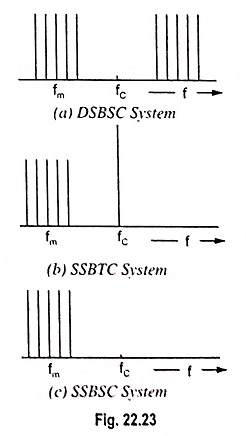Types of Amplitude Modulation (AM):
As we know already that, one carrier and two sidebands are produced in AM generation. However, it is not essential that all these signals are transmitted to enable the receiver to reconstruct the original signal. One may attenuate or altogether remove the carrier or any of the sidebands without affecting the communication process. Accordingly there are 3 types of Amplitude Modulation (AM) in suppressed component systems viz. namely
- DSBSC (double sideband suppressed carrier) system,
- SSBTC (single sideband transmitted carrier) system and
- SSBSC (single sideband suppressed carrier) system.
In this types of amplitude modulation in DSBSC system, as its name indicates, carrier component is altogether removed resulting in saving of enormous amount of power. From earlier discussion, it is known that carrier signal contains two-third of total transmitted power for 100% modulation. It is shown in Fig. 22.23 (a)
In this types of amplitude modulation in SSBTC system, one side-band is suppressed and the carrier and other sideband are transmitted, as shown in Fig. 22.23 (b). In this case one-sixth of total transmitted power is saved for 100% modulation.
SSBSC system consists in transmitting only one sideband and suppress the other sideband and the carrier, as shown in Fig. 22.23 (c). It utilizes the fact that the intelligence or message is contained in each sideband and not in the carrier. Two sidebands being the exact images of each other, carry the same audio intelligence. Thus, all information is available in one sideband only, and one sideband along the carrier can be discarded with no loss of intelligence.
However, for demodulation purpose at the receiving end, carrier is necessary. Hence in this system, carrier is re-inserted at the receiving end in proper phase, frequency and amplitude. The received sideband and the re-inserted carrier are then mixed in a demodulator to get back the original signal.
The advantages of SSBSC (or SSB) system are given below:
- Smaller operating cost.
- 9 to 12 dB improvement in signal/noise power ratio in the reproduced output at the receiving end. This is because SSB signal has narrower bandwidth, therefore, a narrower passband is permissible within the receiver, thereby limiting the noise pickup.
- Small sized power supply requirement—very important in a spacecraft.
- Half bandwidth per channel multiplexing twice as many channels in a given frequency range.
- 83.3% saving in total transmitted power.
- Removal of distortion due to selective fading.
- Reduction in carrier interference with other stations.
- Some privacy automatically provided.
Of course, the receiver for the SSB system gets complicated and the use of SSB system is, therefore, limited to radio telephony. The standard or double-sideband full-carrier (DSBFC) transmission system is widely used in broadcasting because of its relative simplicity of its modulating equipment.
There are various methods of suppressing carrier and one sideband. However, the carrier is suppressed always by employing some form of balanced modulator. For suppression of one sideband in SSB system, the following three methods are commonly employed.
- Filter method
- Phase shift method and
- Weaver’s method.
